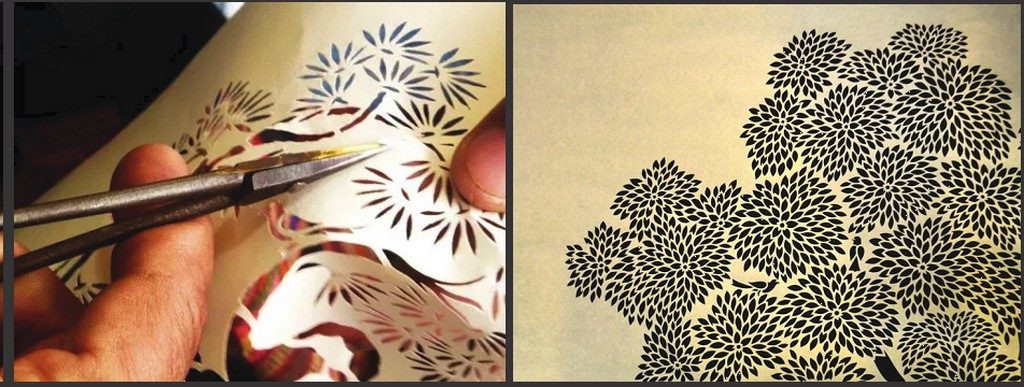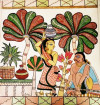We are all familiar with the Hindu Deity Lord Krishna. He is one of the most beloved Gods worshiped by billions of Indians. Every year festivals like Janmasthami and Holi are celebrated and enjoyed by people throughout the country in his honor. But worshippers don’t just celebrate or pray. They have different ways to express their devotion. Some pray, some sing songs and dance. Today we are going to learn about something unique. Our ancestors found a very engaging way to keep themselves busy and offer their prayers at the same time, in the form of art known as Sanjhi Art.
History and Origin
Uttar Pradesh is a land that is rich in cultural heritage. It is the birthplace of Lord Shri Ram and Krishna, and hence it is also the birthplace of the art form known as Sanjhi.
The word Sanjhi is derived from two Hindi words- ‘sajja’ meaning decoration and ‘saanjh’ meaning dusk. Here dusk is significant because the paintings were revealed at that time of the day. Even the process of making this art is quite unique. Whenever we come across the word Art we always think about various types of paints and brushes that are used to draw on a flat surface. But in this form of art, we need a pair of scissors. The artists use a special pair of scissors to cut out designs and motifs on paper, which is mostly handmade. The goal is to create a Stencil. Now, this stencil is placed on a flat surface or water where a rangoli can be made. Sometimes these stencils are also used for a light and sound show where the stencil acts as a screen and a source of light is placed behind the screen which enables us to clearly see the images formed by the motifs on the stencil.
The origins of this art can be found in the folk and lore of this culture. Sanjhi art was brought to the spotlight in the 15th and 16th centuries in the Vaishnava temples. Later, contemporary art themes were added during the Mughal period to achieve a different overview. The Brahmin Priests practiced this highly refined art form. A very few temples in Vrindavan still practice this form of art.
Themes & Motifs
As explained in the mythology, Krishna’s beloved consort Radha used to make these paintings by sticking colored stones, metal foils, and flowers on freshly dung plastered walls, to attract his attention towards her. Inspired by Radha, her Sakhis or Gopis did the same. In Vrindavan, this art is made at a particular time of the year to please Krishna.
Back when this art form came into practice, people used tougher surfaces like rough paper and banana leaves to make the stencils. But nowadays, recycled handmade paper is used to make this art. This art mainly represents lores and tales related to the daily life and activities of Lord Sri Krishna. A glimpse of life in Vrindavan was beautifully expressed through Sanjhi art. We can identify peacocks, butterflies, trees, bullock carts, cows, horses, etc in this art. Usually, we can see the artist’s love and devotion toward Lord Krishna through this artform. Just like Radha, it is the artist's desire to seek the attention of their beloved Lord.
Renowned Artists
A few weeks ago, Our Prime Minister, Sri Narendra Modi gifted a Sanjhi art Panel to Mr. Joe Biden, the President of the United States. Not only did that artwork represent our culture, but it also gave an opportunity for the whole world to see how incredible the artists of India are! That panel was designed by Late Chainsukh Das Verma. His father Narayan Das Verma was awarded with the Master Craftsman award for his outstanding skills with this artform. Sanjhi art has been practiced in the Verma Family for generations. Sanjhi art in the Verma family is carried on by brothers Ajay, Vijay, and Mohan.
Another Artist Ram Soni got an opportunity to display one of his works in the Delhi Metro Station. He won a National Award in 2005 for his works on Sanjhi Art. He also contributed to creating a 26 meter long and 11-meter-wide handmade paper chandelier, assisted by about 8000 children associated with the organization Pratham. This Chandelier is going to be displayed at a fundraising event in London later this year.
Current Scenario:
Today, Sanjhi art can be found in various places including small household items like curtains, lamp shades, wall frames, and even coasters. As mentioned earlier, these artworks are a part of public property as well like on metro stations and wall mountings. Even the 2010 Commonwealth Games Held in Delhi had pictograms made of Sanjhi art. Online platforms, such as ARTSofINDIA.in, are constantly working to uphold such arts and recognize and acknowledge the artists across the country.
Sanjhi art has also opened up opportunities for entrepreneurs like Puja Ajmera, to introduce a cultural twist to our daily lives. She was interested in this art form when she tried to cut out a drawing made on paper. The outcome inspired her to make artworks that have their roots in Sanjhi Art.
Picture Source: JD Institute of Fashion Technology



